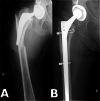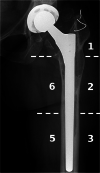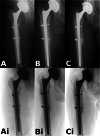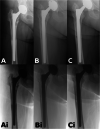Differences between proximal bone remodeling in femoral revisions for aseptic loosening and periprosthetic fractures using the Wagner SL stem
- PMID: 33596872
- PMCID: PMC7890820
- DOI: 10.1186/s12891-021-04062-6
Differences between proximal bone remodeling in femoral revisions for aseptic loosening and periprosthetic fractures using the Wagner SL stem
Abstract
Background: Monoblock taper fluted stems have been reliably used to treat proximal femoral periprosthetic fractures (PFF) and femoral aseptic loosening (AL). Although proximal femoral remodeling has been observed around the Wagner Self-Locking (SL) stem, the exact characteristics of this process are yet to be established. Our aim was to compare the remodeling that takes place after femoral revisions for PFF and AL.
Methods: Consecutive patients between January 2015 and December 2017 undergoing femoral revision using the Wagner SL stem for PFF or AL without an extended trochanteric osteotomy (ETO) or bone grafting were selected from our database. Radiological follow-up was performed using plain antero-posterior hip radiographs taken postoperatively and at 3, 6, 12 months and at 24 months. The Global Radiological Score (GRxS) was utilized by four blinded observers. Intra and interobserver variability was calculated. Secondary outcome measures included the Oxford Hip Score and the Visual Analog Scale for pain.
Results: We identified 20 patients from our database, 10 PFF and 10 AL cases. The severity of AL was Paprosky 2 in 2 cases, Paprosky 3A in 2 cases and Paprosky 3B in 6. PFF were classified as Vancouver B2 in 7 cases and Vancouver B3 in 3 cases. Patients undergoing femoral revision for PFF regained 89% (GRxS: 17.7/20) of their bone stock by 6 months, whilst patients with AL, required almost 2 years to achieve similar reconstitution of proximal femoral bony architecture 86% (GRxS: 17.1/20). Inter-observer reproducibility for numerical GRxS values showed a "good" correlation with 0.68, whilst the intra-observer agreement was "very good" with 0.89. Except immediate after the revision, we found a significant difference between the GRxS results of the two groups at each timepoint with pair-wise comparisons. Functional results were similar in the two groups. We were not able to show a correlation between GRxS and functional results.
Conclusions: Proximal femoral bone stock reconstitutes much quicker around PFF, than in the cases of AL, where revision is performed without an ETO. The accuracy of GRxS measurements on plain radiographs showed good reproducibility, making it suitable for everyday use in a revision arthroplasty practice.
Keywords: Bone remodeling; Bone-prosthesis Interface; Hip prosthesis; Periprosthetic fractures; Prosthesis loosening; Revision arthroplasty.
Conflict of interest statement
The authors declare that they have no competing interests.
Figures









Similar articles
-
Radiographic and Clinical Outcomes of Modular Tapered Fluted Stems for Femoral Revision for Paprosky III and IV Femoral Defects or Vancouver B2 and B3 Femoral Fractures.J Arthroplasty. 2020 Apr;35(4):1069-1073. doi: 10.1016/j.arth.2019.11.039. Epub 2019 Nov 30. J Arthroplasty. 2020. PMID: 31870582
-
Nonmodular Tapered Fluted Titanium Stems Osseointegrate Reliably at Short Term in Revision THAs.Clin Orthop Relat Res. 2017 Jan;475(1):186-192. doi: 10.1007/s11999-016-5091-x. Epub 2016 Sep 26. Clin Orthop Relat Res. 2017. PMID: 27672012 Free PMC article.
-
Mid-term outcomes following transfemoral revision of total hip arthroplasty for Vancouver B2/B3 periprosthetic fractures.Injury. 2022 Feb;53(2):653-660. doi: 10.1016/j.injury.2021.11.036. Epub 2021 Nov 17. Injury. 2022. PMID: 34862036
-
Fracture fixation versus revision arthroplasty in Vancouver type B2 and B3 periprosthetic femoral fractures: a systematic review.Arch Orthop Trauma Surg. 2020 Oct;140(10):1381-1394. doi: 10.1007/s00402-020-03332-7. Epub 2020 Feb 21. Arch Orthop Trauma Surg. 2020. PMID: 32086558 Free PMC article.
-
Periprosthetic Femoral Fractures-Beyond B2.J Am Acad Orthop Surg Glob Res Rev. 2024 Aug 6;8(8):e23.00135. doi: 10.5435/JAAOSGlobal-D-23-00135. eCollection 2024 Aug 1. J Am Acad Orthop Surg Glob Res Rev. 2024. PMID: 39110721 Free PMC article. Review.
Cited by
-
Comparative analysis of the quality of life regarding patients who underwent hip replacement in public versus private hospitals in Hungary.Sci Rep. 2024 May 1;14(1):10031. doi: 10.1038/s41598-024-60720-4. Sci Rep. 2024. PMID: 38693216 Free PMC article.
-
Comparison of Cylindrical and Tapered Stem Designs for Femoral Revision Hip Arthroplasty.J Clin Med. 2024 Mar 18;13(6):1745. doi: 10.3390/jcm13061745. J Clin Med. 2024. PMID: 38541969 Free PMC article.
References
-
- Huang Y, Shao H, Zhou Y, Gu J, Tang H, Yang D. Femoral bone remodeling in revision Total hip Arthroplasty with use of modular compared with Monoblock tapered fluted titanium stems: the role of stem length and stiffness. J Bone Joint Surg Am. 2019;101(6):531–538. doi: 10.2106/JBJS.18.00442. - DOI - PubMed
MeSH terms
LinkOut - more resources
Full Text Sources
Other Literature Sources
Medical

